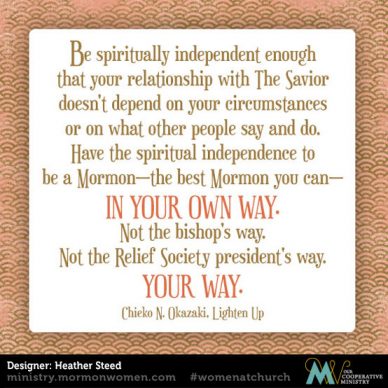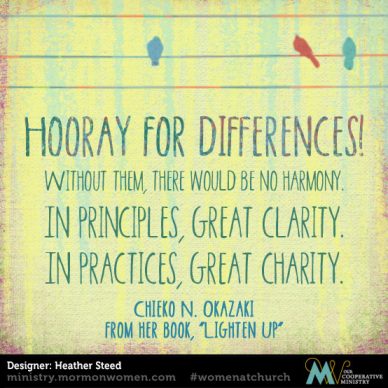Gospel Doctrine Lesson #46; Doctrine and Covenants 57:1–3; 64:33–43; 82:14–15; 97:8–28; 105:1–12; Moses 7:12–19, 61–63, 68–69; Articles of Faith 1:10
In studying the lives and words of Mormon women, different women provided me deeper understanding of what it means to live the Gospel of Jesus Christ. Emmeline Wells taught me about leadership and the value of women’s voices. Sarah Granger Kimball taught me about proactivity and integrity. Jane Manning James taught me about hope and resilience. The woman that showed me what it means to live a Zion life was Chieko Okazaki.
Chieko Okazaki was born in Hawaii to Buddhist parents of Japanese descent. She joined the church as a teenager and eventually moved to the mainland, where she worked as an elementary school teacher and principal. In 1961, she became the first non-Caucasian to serve on a general auxiliary board when Florence S. Jacobsen appointed her to the YWMIA board, and she would serve from 1990-1997 as first counselor to General Relief Society President Elaine Jack.
Through her life and writings, she taught me many important truths about Zion.
First, Zion is creating spaces of inclusion
Principles of Zion and diversity were at the core of Okazaki’s ministry. She persistently brought forward the perspectives and concerns of women that were infrequently discussed in church settings at the time, especially single sisters, working mothers, divorcees, and those from varying cultural backgrounds. She celebrated what we gain from each other when we can adjust our practices for greater inclusion and understanding.
She discussed the work and deliberate effort it takes to create a Zion people. Okazaki taught, “To make our diversity a strength, not a divisiveness, we need to communicate more and communicate better. As sisters in the gospel, let’s talk. Let’s share experiences. When we see or hear something we don’t understand, let’s check it out. Let’s ask, ‘Can you tell me what it means when you say or do this?’”
Okazaki taught me that as a Zion people, we need to thoughtfully engage with difficult questions about gender, race, sexuality, and culture to fulfill that process of being of one heart. It requires patience with each other while we listen to and learn from these different perspectives, and courage to ask for what we need compassionately, articulately, and in a spirit of unity.
Second, Zion is seeing everyone’s presence in our midst as a gift
In her conference talk Bottles and Baskets, Okazaki listed the varied life circumstances of women she served in the process of her leadership, many facing difficult challenges, and said, “Not many of these women thought they were giving me a gift. Most of them thought they were asking for help. But all of them blessed me as I listened and learned from them.”
Okazaki taught me to examine if we see people that way in our branches, wards, and the church at large. Can we look all people in the eye and say to ourselves, “What can I learn from her?” Can we view our interactions with people that supported a different political platform, seem to constantly be falling apart and need rescue, seem too sugar-coated or too prickly, too wealthy or too impoverished, or so forth as a gift?
I’ve been amazed by how often I’ve been called to serve alongside someone I thought I wouldn’t have much connection with, and then been blown away by the goodness, talents, and insight I found when I saw them in action, using the gifts and experiences God gave them in their unique ministry. And my participation in this church has exposed me to perspectives and life experiences I would never have access to otherwise. My life is richer for it.
Third, you don’t wait for Zion to invite you in – you claim it.
Okazaki knew what it was to face prejudice and discrimination amid the body of Saints. She and her family moved to Salt Lake City in 1951, when the wounds of WWII were still fresh. They could not buy life or car insurance. They only succeeded in purchasing land for a home because a friend sold them some of his own property – no one wanted to sell to a Japanese-American family. People acted in prejudiced ways, intentionally and not.
The Okazakis chose to make a place for themselves in Zion. They had faith that the Saints around them could be better when they understood better. They got to work introducing themselves to neighbors and ward members, proactively serving, passing out fortune cookies, refusing to take offense, and loving relentlessly. Before long, they became essential and beloved parts of every community where they lived.
Okazaki showed me the value of creating spaces for our unique selves in Zion through love, forgiveness, and creativity.
Finally, creating Zion brings joy.
There is joy and power to be found in bringing our authentic selves into service in God’s church, and in making room for others to do the same. Okazaki modeled how to accomplish it through communication, empathy, forgiveness, and innovation.


